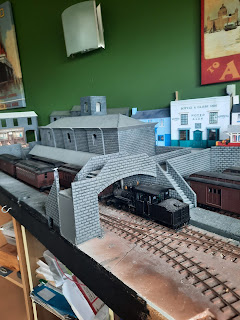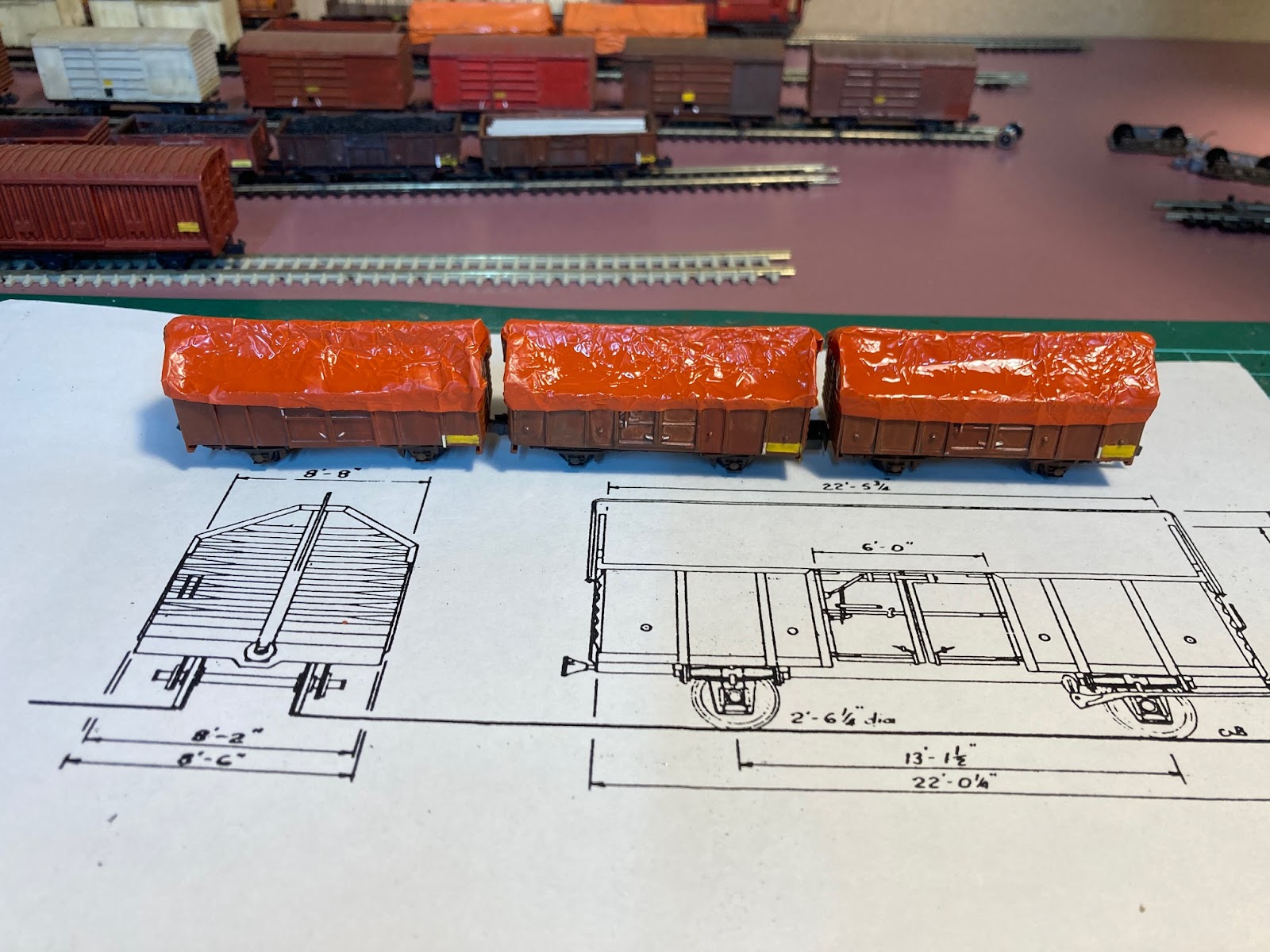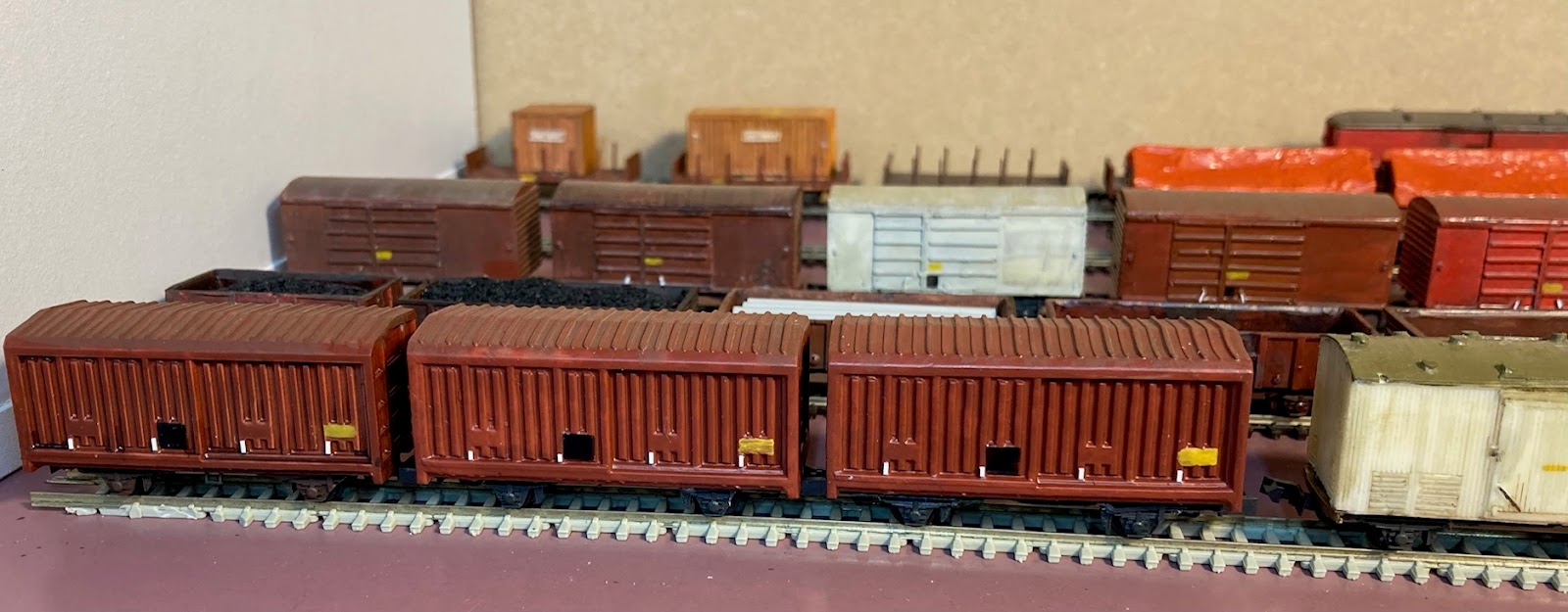DB juggling ten projects at once:
Lord Dandruff the First stopped by a month ago, and we had a carful browse through some of my rolling stock that had been bundled up in paper towels and boxes for the last ten years. We didn't get to the bottom of all the boxes, and didn't unwrap much, but there was a lot that had been long forgotten.
Yesterday I went dumpster diving to the bottom and unwrapped most of the mysterious items.
 |
| OK, apart from a bendy one at the bottom. |
The Good:
The 'Hokitika' container train of commercial 40 foot containers and white cast TBC insulated jobs on resin cast UKs look decent, other than a few busted MicroTrains couplers and some misplaced wheels. A west coast coal train from c2010 is about 80% done (CBs and CWs) plus there are four unused CE tops from Shapeways in the bin.
Ooo, Speights tanktainer! RFL containers, CF, Spaceracer, Well wagon, Urea wagon. Some nice Trackgang UR and LPA wagons. My own cast KP and XP tops look decent. Most of the HCC coal container train looks ok. I have a few good looking four wheelers of various types - scratchbuilt NCs, and an MC, plus a few LC and LAs made from someone else's tops, five nice YCs from the 90s based on Rhys' cast hoppers. Plus two fairly basic, but acceptable log wagons and a SpaceLiner from the early days.
A lot of small projects fixing, painting, detailing and weathering will have this lot shipshape in no time.
The Bad:
That PFC flour bomb doesn't look that good up close. Far worse are some of my first early-90s efforts: rudimentary container wagons (the 'Japan Line' UK above for example) that should be retired, the basic (yet mildly-effective) RoadRailer on its old Atlas rapido bogies.
For some reason I still have 15 LCs molded in Flashfix polyester bog from my awful master (my first attempt at casting anything).We always put Rhys' LCs at the head of the train on Otaki to Cass because they looked better than the 18 or 20(?) LCs that I had.
 |
| Eeek |
I have a 12 wagon stone train filled with limestone! I must have cast the LA tops about 2012, but don't think it was blogged about. The LAs look a little big to my eye so I'll have to dig out my plans.
My cast side-opening 10 foot green and 20 foot blue containers are too wide and tall, but more on them below.
The Ugly:
About five of the container wagons are warped. Some subtly, one quite dramatically.
 |
| The bends |
Some of the containers suffer from sticky resin syndrome and will be binned.
 |
| Sticky Blue Star Line to be binned |
The 10-foot green containers have shrunk oddly in some dimensions and the styrene handgrabs and spacers have melted into a sticky mess.
 |
| Cartoon containers |
The two XCs have melted/softened their Peco chassis. One of the couplers pulled in half like its shank was made of bubblegum. Strangely, the KPs made at the same time are fine, and a whole bunch of spare cast containers at the bottom of a box were fine too.
 |
| Axleboxes, sides and coupler very soft. |
I'm guessing its a particular brand of glue (contact or UHU style) that I used at one stage to fix some resin cast tops to Pecos; and resin containers to resin flat wagons. The glue reacted with the resin and emited a gas that plastic doesn't like. Having things locked away in boxes with no fresh airflow can't have helped. The Blog's resident chemist will likely weigh in on this once he's fired up his scanning electron spectral analyser.
The XCs have been cleaned and fixed with a new chassis - superglued on! I penciled a note to myself to discover in case this happens again:
A mildly bent container wagon was stripped of containers and bogies, and straightened successfully after 10-15 seconds under a hot tap, followed by cooling under the cold. Reassembled (with superglue!) it seems fine, so I will try this with the others.
 |
| ^ Bent |
 |
| ^ Straightening |
 |
| ^ Flat flat wagon |
 |
| ^ With containers reattached. |
A few sticky containers are being binned. I replaced the blue sticky side opener on the Speights wagon with the best of the green 10 footers even though its a bit big:
The PK with the greenies has picked up two Associated Container Transport containers from the 80s off a UK that will be straightened, and will keep its nice GraFar bogies with rapido couplers (see para below).
Doing this has me thinking about my varied and random trains, some of which have a mix of couplers. I'll probably convert the 'modern stuff' to MicroTrains and keep the four wheelers and a few bogie wagons that suit an 80s train with the rapido couplers. The PFC flour job, roadrailer and maybe the NZR container wagons would be more at home on a 90s express goods train so will get MT couplers.
It's also started me thinking about a few things that are missing from the trains. White ventilated Z covered wagons are probably the most obvious omission from the 80s train. The work train needs a plow van. And I need a bunch of additional container wagons, although I have a pair of MMW IAs to make up. Now that I am not modelling Moana, the Hoki container train can be more generic, and some of its white TBCs might be backdated with NZR logos.
Much to do.









































